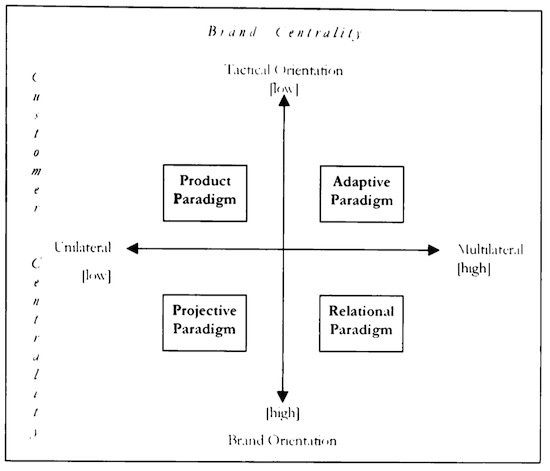This post is part of my bachelor paper ‘The Evolving Role of Creativity in Brand Management’. You can see the other posts and the table of contents here.
—
To speak of brand management as one clear and perfectly defined concept or management process would oversimplify the current state of research and practice on the topic. Shaped by different company practices, widely discussed ‘recipe’ books by practitioners (Roberts et al. 2005; Ries 2002), numerous proprietary models of advertising agencies and brand consultancies (Fuchs & Unger 2007, p.33ff; Tropp 2004, p.151ff), and different schools of academic research on the topic there are many different perspectives onto what brand management is and how it works. According to Louro and Cunha (2001, p.853) there are four brand management paradigms. These paradigms
“constitute an organization’s portfolio of implicit assumptions, collective beliefs, values and techniques concerning the why (the objectives and performance measures of brand management), the what (the concept of brands), the who (the organizational structure of brand management) and the how of branding (the variables of brand management)”.
Figure 1: Brand Management Paradigms, taken from Louro & Cunha (2001)
They are located in a coordinate system on two central dimensions of current academic and practitioner discussions about brand management: brand centrality and consumer centrality. Brand Centrality stretches from a tactical orientation, which sees brands for their mere signifying and legal value and branding as a residual decision mostly dealing with the advertising of product, to brand orientation which sees brands as “central platforms, in the form of guiding vision and values, and core expressions, in the form of particular marketing mix configurations, of an organisation’s strategic intent (Kapferer & Mayring 1992)“ (Louro & Cunha 2001, p.855) Consumer Centrality, on the other hand, refers to the degree to which managers belief in the consumers’ involvement in the process of value creation, which ranges from a unilateral approach seeing consumers as the mere recipients of value created by organisations and multilateral approaches in which consumers are seen as co-contributors of value (Louro & Cunha 2001, p.855). The distinctive paradigms will now be introduced, starting with the product paradigm, followed by the projective and adaptive paradigm.
—
Fuchs, W. & Unger, F., 2007. Management der Marketing-Kommunikation 4th ed., Springer, Berlin.
Kapferer, J.-N. & Mayring, P., 1992. Strategic brand management, Kogan Page London.
Louro, M.J. & Cunha, P.V., 2001. Brand management paradigms. Journal of Marketing Management, 17(7), pp.849–875.
Ries, L., 2002. The 22 immutable laws of branding: how to build a product or service into a world-class brand, Harper Paperbacks.
Roberts, K., Lafley, A.G. & Nagymáté, O., 2005. Lovemarks, PowerHouse Books.
Tropp, J., 2004. Markenmanagement: Der Brand Management Navigator. Markenführung im Kommunikationszeitalter, VS Verlag.

